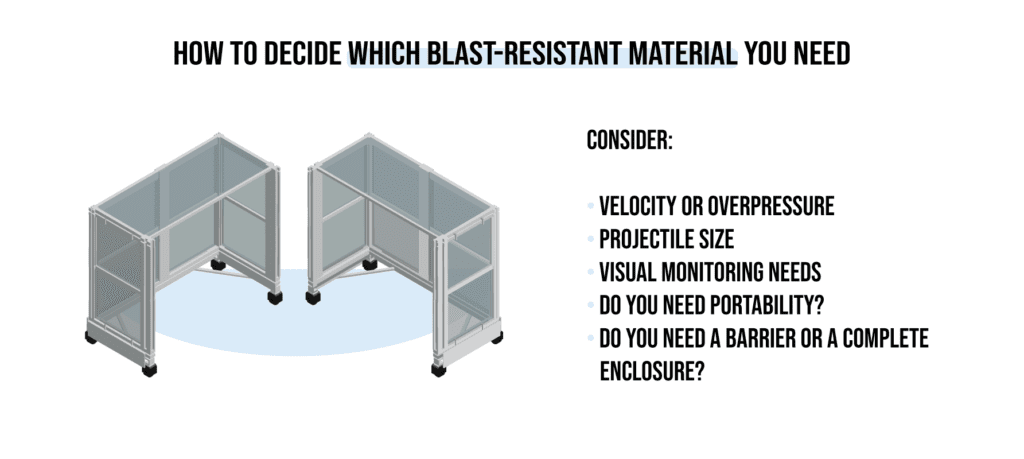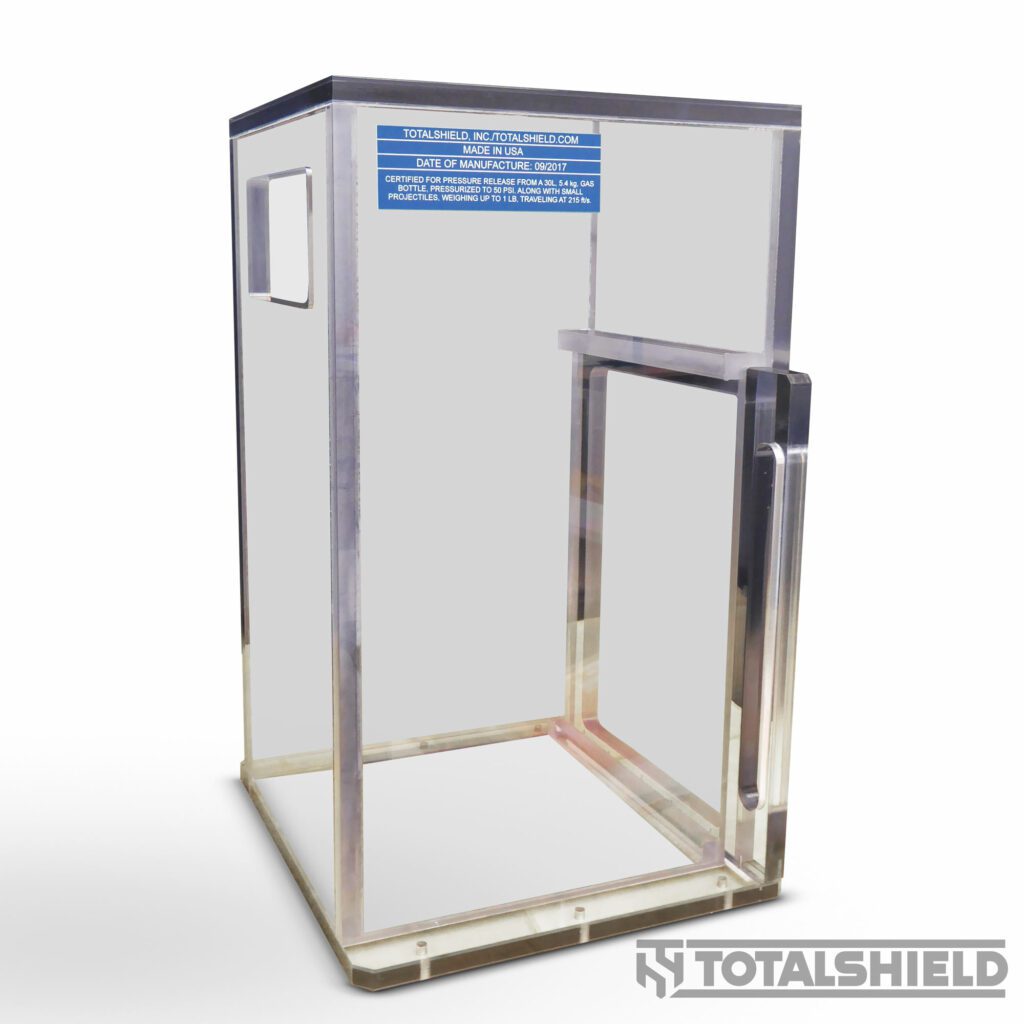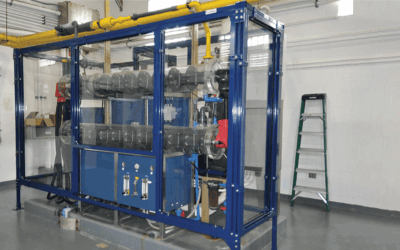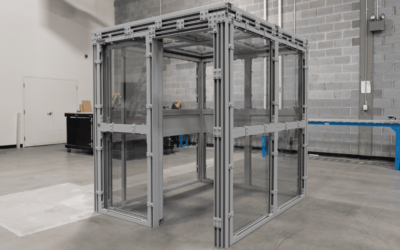When thinking about blast-shielding products, you might believe that different materials can be used interchangeably. However, each industrial process or scenario is different. Shielding materials respond differently to deformation, shock, pressure waves, and ballistic impact.
That is why every shielding product should be specially designed for the specific application it will be used for, so its material characteristics are appropriately protective against the potential threat.
Different blast-resistant materials are better suited for particular applications. Is there one material that is “best” for blast resistance? The short answer is: it depends. Keep reading to understand why.
What are blast shields usually made from?
Shielding enclosures can be made with the following materials:
- Polycarbonate (PC)
- Steel
- Fiberglass
- Plexiglass
- Safety glass
Steel is probably the most common. These enclosures are usually called “boom boxes or rooms”, that are welded together and designed to mitigate a blast. Some of these structures can have polycarbonate windows.
At TotalShield, we design and manufacture our shielding solutions with polycarbonate panels mounted in a modular framing system made from steel and aluminum.
Why does the blast-shielding material type matter?
As you prepare your next testing procedure, you may ask yourself what material your blast containment enclosure should be constructed from. Metal, polycarbonate, fiberglass? As we have mentioned, you have plenty of options.
Operations and testing can vary widely depending on the process, equipment, and projected end results, and various transparent and non-transparent materials can be used for impact and blast protection. All shielding materials have characteristics, capabilities and advantages that might suit one application more than another. This depends on the design parameters for impact protection:
- Pressure
- Projectile size and mass
- Velocity or overpressure
- Visual monitoring needs
If visibility is not needed, for example, a steel enclosure or a Kevlar Shielding Blanket may be a suitable option. Size and space requirements can also determine the material used. Another consideration is whether the enclosure needs to be mobile (weight is a consideration) or can be fixed in place.
Once again, the application of such a product will determine the proper shielding material.

The TotalShield test archive allows our engineers to determine the best shielding solutions. We check the available data (obtained over 25 years in partnership with leading research institutes) or conduct new tests for novel scenarios. We also extend our shielding solutions’ impact and blast resistance capabilities by utilizing proprietary framing, manufacturing, and assembly techniques that enhance the blast resistance of the materials used.
Choosing the right shielding material is of the utmost importance when it comes to the safety of your employees.
Polycarbonate vs. Acrylic or Safety Glass
Polycarbonate is known by various trade names, including Lexan, Palsun, Merlon, and Tuffak’. In the United States, it is often referred to synonymously as Lexan due to the popularity of the trade name as marketed by the GE corporation. This resin thermoplastic is used in everything, from race car windshields to kitchenware.
On the other hand, acrylic sheeting is most often referred to by its trade name plexiglass and is a transparent thermoplastic homopolymer. Acrylic is used in a variety of products, from windows to commercial signs and displays.
Safety glass is a broad term including different types of glass manufactured to make them less likely to break. When safety glass does break, it should also have features that make it less likely to cause harm. In the context of safety enclosures, laminate glass is the most common form of safety glass used. Laminated glass is made of two or more panes of annealed glass joined together by a layer of plastic. Some types of laminated glass have multiple alternating layers of plastic and glass.
We do not use acrylic or safety glass in any of our products because they are dramatically less impact and blast-resistant than polycarbonate. Polycarbonate is 250 times more impact resistant than safety glass and 30 times more impact resistant than acrylic. In addition, polycarbonate has better heat and chemical resistance than acrylic and is much lighter than safety glass.
Polycarbonate strength vs. steel: Which one is better?
Polycarbonate can withstand blasts of over 900 psi and is about 200 times stronger than steel by weight, and is also more flexible than steel. This feature allows polycarbonate to flex and return to its original shape, dissipating impact energy.
Unlike steel, polycarbonate also offers a lighter-weight solution with visual clarity. Its clear property allows constant monitoring of your machinery operations without compromising your staff’s safety, making it one of the most effective materials against impact and blast.
However, while polycarbonate has qualities that steel does not, it is not always a better option than steel. For example, it does not perform well when rigidly held, such as bolting. Its performance is also affected when holes have been drilled through.
This is why our proprietary framing system does not rigidly pin or pinch the polycarbonate panels but instead holds the panel in a continuous gasketed channel. In addition, when intrusions need to occur into a TotalShield enclosure, we provide steel access panels that can be drilled without compromising the enclosure’s integrity.

Why we prefer polycarbonate enclosures
Our polycarbonate panels are modular, making them a non-permanent structure that can be more easily moved than a welded steel structure. The modularity also allows for easy material replacement if damage occurs.
As mentioned previously, we prefer polycarbonate panels to all other transparent materials because no other material can match its impact resistance.
In the following video, you can view the TotalShield’s tests we conducted for our HETShield:
Here, we used a BR1250 polycarbonate 1.25” thick sheet, with a projectile of steel plug 1.75” long x 1” diameter .297 lbs at 177.7 m/s
We’ve also made a test using a 1.25” thick bullet resistant acrylic panel, using the same parameters for the projectile, this time at 173.7 m/s
As you can see, under similar conditions polycarbonate panels proved to be a higher impact-resistant solution than acrylic.
In summary, the advantages of polycarbonate include the following:
- Can be exposed to high temperatures (up to 240°F) and is non-flammable
- Highly resistant to chemicals
- 250x better impact resistance than glass
- 30x better impact resistance than plexiglass
- 200x stronger than steel by weight
- 6x lighter than glass
- Long lifespan, eliminating unnecessary replacement costs thanks to its overall durability
Final thoughts
Not all enclosure materials are created equal. We have spent 25 years evaluating the material and designs in our TotalShield product line to ensure they have the optimal attributes of:
- Impact resistance
- Blast resistance
- Heat and chemical resistance
- Maintainability
- Long lifespan
- Modularity
When requesting a shielded enclosure from TotalShield, you can be assured that we’ll work with you to understand your testing requirements and to design a shielding solution that is right for your business.









